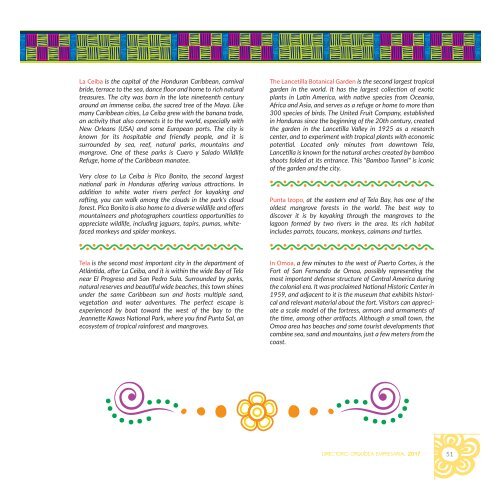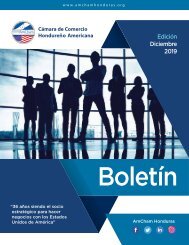Turismo
You also want an ePaper? Increase the reach of your titles
YUMPU automatically turns print PDFs into web optimized ePapers that Google loves.
La Ceiba is the capital of the Honduran Caribbean, carnival<br />
bride, terrace to the sea, dance floor and home to rich natural<br />
treasures. The city was born in the late nineteenth century<br />
around an immense ceiba, the sacred tree of the Maya. Like<br />
many Caribbean cities, La Ceiba grew with the banana trade,<br />
an activity that also connects it to the world, especially with<br />
New Orleans (USA) and some European ports. The city is<br />
known for its hospitable and friendly people, and it is<br />
surrounded by sea, reef, natural parks, mountains and<br />
mangrove. One of these parks is Cuero y Salado Wildlife<br />
Refuge, home of the Caribbean manatee.<br />
Very close to La Ceiba is Pico Bonito, the second largest<br />
national park in Honduras offering various attractions. In<br />
addition to white water rivers perfect for kayaking and<br />
rafting, you can walk among the clouds in the park's cloud<br />
forest. Pico Bonito is also home to a diverse wildlife and offers<br />
mountaineers and photographers countless opportunities to<br />
appreciate wildlife, including jaguars, tapirs, pumas, whitefaced<br />
monkeys and spider monkeys.<br />
The Lancetilla Botanical Garden is the second largest tropical<br />
garden in the world. It has the largest collection of exotic<br />
plants in Latin America, with native species from Oceania,<br />
Africa and Asia, and serves as a refuge or home to more than<br />
300 species of birds. The United Fruit Company, established<br />
in Honduras since the beginning of the 20th century, created<br />
the garden in the Lancetilla Valley in 1925 as a research<br />
center, and to experiment with tropical plants with economic<br />
potential. Located only minutes from downtown Tela,<br />
Lancetilla is known for the natural arches created by bamboo<br />
shoots folded at its entrance. This "Bamboo Tunnel" is iconic<br />
of the garden and the city.<br />
Punta Izopo, at the eastern end of Tela Bay, has one of the<br />
oldest mangrove forests in the world. The best way to<br />
discover it is by kayaking through the mangroves to the<br />
lagoon formed by two rivers in the area. Its rich habitat<br />
includes parrots, toucans, monkeys, caimans and turtles.<br />
Tela is the second most important city in the department of<br />
Atlántida, after La Ceiba, and it is within the wide Bay of Tela<br />
near El Progreso and San Pedro Sula. Surrounded by parks,<br />
natural reserves and beautiful wide beaches, this town shines<br />
under the same Caribbean sun and hosts multiple sand,<br />
vegetation and water adventures. The perfect escape is<br />
experienced by boat toward the west of the bay to the<br />
Jeannette Kawas National Park, where you find Punta Sal, an<br />
ecosystem of tropical rainforest and mangroves.<br />
In Omoa, a few minutes to the west of Puerto Cortes, is the<br />
Fort of San Fernando de Omoa, possibly representing the<br />
most important defense structure of Central America during<br />
the colonial era. It was proclaimed National Historic Center in<br />
1959, and adjacent to it is the museum that exhibits historical<br />
and relevant material about the fort. Visitors can appreciate<br />
a scale model of the fortress, armors and armaments of<br />
the time, among other artifacts. Although a small town, the<br />
Omoa area has beaches and some tourist developments that<br />
combine sea, sand and mountains, just a few meters from the<br />
coast.<br />
DIRECTORIO ORQUÍDEA EMPRESARIAL 2017<br />
51















